Get your FREE sensory profiles cheat sheet >>click here<<
How to Teach Size of the Problem
Read New Post about why I don’t use this lesson anymore!
If you are a parent, or work with kids, you might notice that some kids can have some pretty disproportionate reactions. Think of the kid that melts down when he wanted the blue cup instead of the green cup. Or your student who drops to the floor in a tantrum when she lost a game of chutes and ladders. These are both small problems, but those reactions are disproportionately big. In this post, I’ll share with you one of my favorite, hands on ways to teach a lesson about the size of the problem.
What is a small problem?
A small problem is one in which you can solve it yourself in almost no time at all. You don’t need to ask anyone for help, and usually you don’t even need to tell anyone about this problem. It happens, you have a small (or no) reaction, then you solve it yourself.
Here’s a list of examples for expected small reactions and solutions to small problems:
| Problem | Reaction | Solution |
| A colored pencil broke while you were using it | no reaction, or small reaction like, “oops!” | Sharpen the pencil or get a different pencil |
| You didn’t get to go first in the game | small reaction, or no reaction, like “okay, maybe I can go first the next time” | Be flexible, use your inner coach to tell you that you can go first next time. |
| Your mom gave you goldfish for lunch instead of pretzels | small reaction, or no reaction, like “oh well, I’ll ask mom for pretzels tomorrow” | Eat the goldfish and be flexible. Ask mom nicely later if she could pack you pretzels tomorrow. |
What is a medium problem?
A medium problem is one in which you need to ask someone else (usually an adult, like a parent or teacher) for help; and it usually takes a little longer to solve and maybe more than 1 person to solve. It would be expected to have a medium sized reaction to this problem. Here are some examples:
| Problem | Reaction | Solution |
| Scraped your knee | A little crying, maybe saying “ouch!” once | Go to the nurse’s office for a bandaid |
| Forgot your lunch at home | feeling a little frustrated, you might cry or whine from being hungry | Ask your teacher to call your parents to drop off your lunch |
What is a big problem?
A big problem is rare to come across: it’s when you need help from “big helpers” like a Doctor, a firefighter, or a policeman. These problems take quite some time to solve and it would be expected and okay to have a big reaction.
| Problem | Reaction | Solution |
| Broke your leg | Screaming and crying in pain | You need to go to the emergency room to get an X-ray and a cast. It will take weeks to heal |
| House fire | Screaming, crying, running | Call 911 and the police and firemen need to come and try to save your house |
Materials Needed:
- 3 different sized cups/buckets: small, medium and big
- 3 different sized balls/objects that fit in each of the cups/buckets you chose

Lesson:
First I demonstrate how there is a small, medium and big cup and small, medium and big balls that fit inside each of them.

Then, I explain how to tell the difference between a small, medium and big problem and hold up the corresponding size cup. We share some examples of each kind of problem.
While holding up one of each of the different sized balls, I talk about how there are also different sizes of reactions, and we practice role-playing what small, medium and big reactions look like.
Then comes the important part: explicitly stating that it’s expected to have the same size reaction to the size of the problem. I state this a couple times, have them repeat it, and demonstrate it by dropping the proper size ball into each cup.
Finally, we talk about why it’s unexpected to have a big reaction to a small problem (as I put a large ball and try to force it into a small cup). The answer is: it looks funny, people feel uncomfortable, it doesn’t fit, it’s not right.
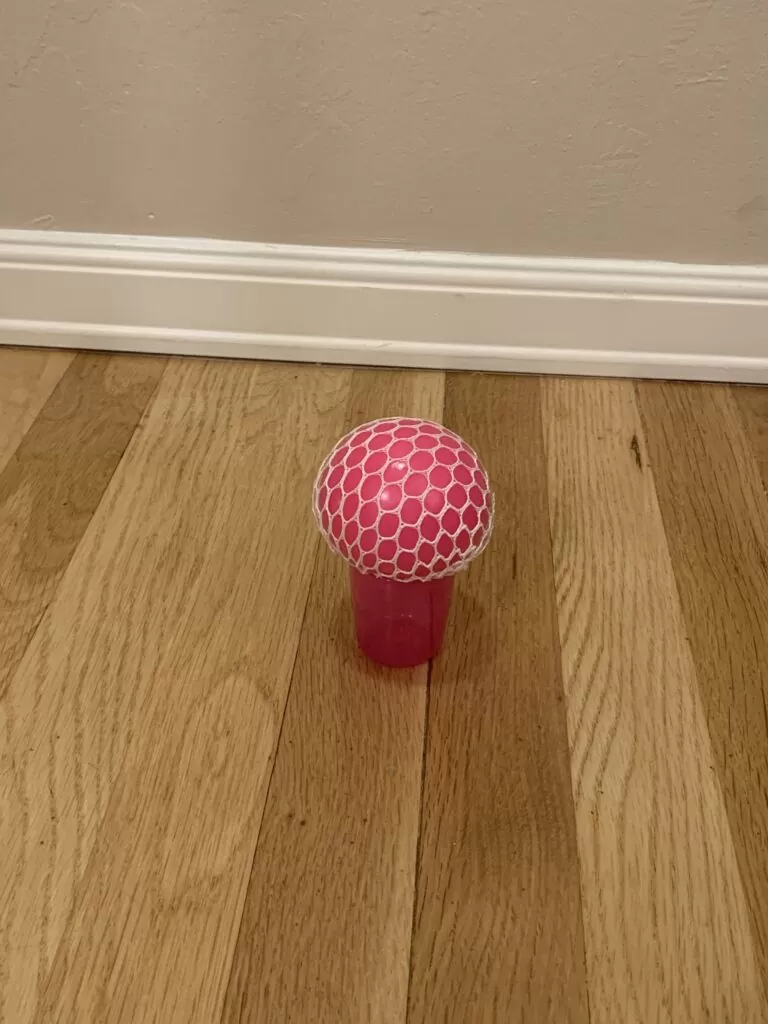
One important note about this lesson:
It’s important to note that this lesson is helpful in developing social emotional skills in little ones, but it should not be used as a strategy in the moment to try to stop a big reaction.
For example, if your child is in the middle of a full on, ‘hulk-mode’ melt down, looking at him and saying, “Johnny, you’re having a big reaction to a small problem” will not only not help the situation, but there’s a good chance it might escalate.
Save the lessons and discussion about the size of the problem when your child is calm and regulated. I like to introduce the lesson once or twice, and then use a reminder discussion as a preparatory statement before going into an activity that might trigger big reactions.
For example, maybe it’s before playing a competitive game of connect 4, I might say something like “Before we start, let’s remember what size problem is it if you lose?”
You could also use this discussion as a reflection discussion after the child has calmed down from a tantrum/melt down, and discuss what the trigger was, and whether it was a small, medium or big problem and if their reaction matched it. Use this as an opportunity to problem solve for future scenarios that might come up.
Where to go to learn more?
If you’re looking for more information on Size of the Problem lessons and other social thinking curriculum, please visit the Social Thinking website.
Read New Post about why I don’t use this lesson anymore!
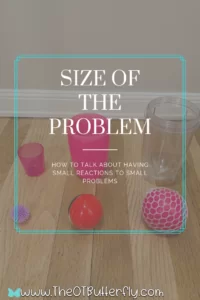

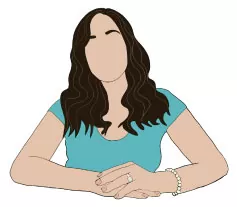
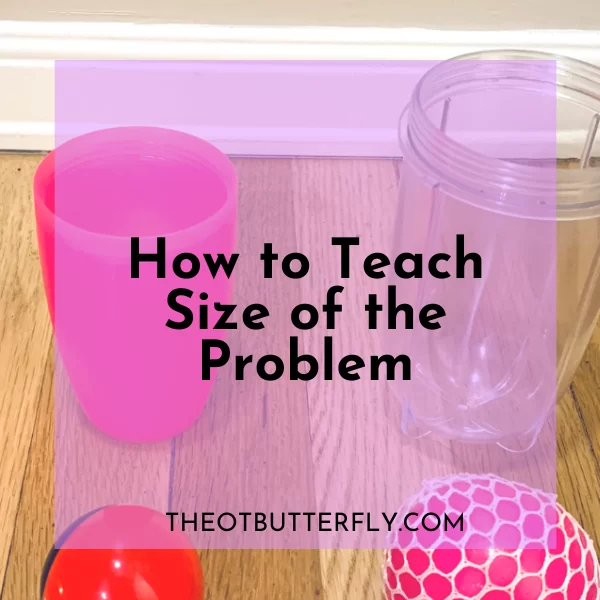
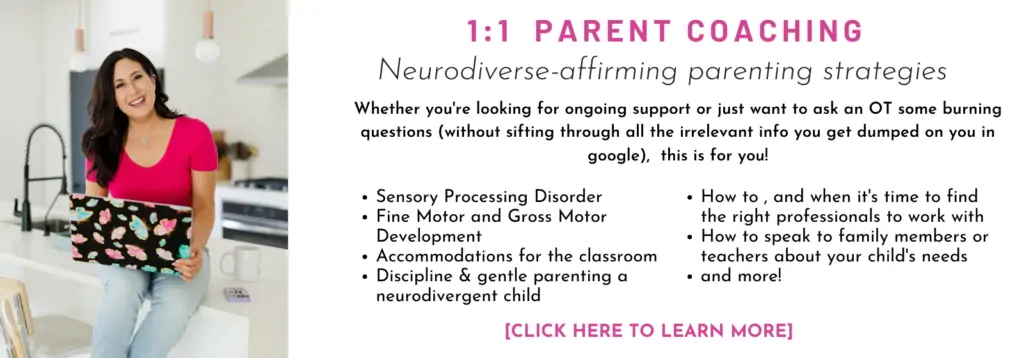



Hello
Thank you for the small, medium and big problem lesson idea with ball and cups. I was wondering if you have any other activities to teach small, medium and big problems please.
Hi Faye! Thanks for your commment, I’m glad you enjoyed the lesson idea. There are a few other activities you can do to illustrate this concept with children, there’s actually a book that talks about it with small, medium and big dinosaurs and you can recreate it with dinosaurs or other stuffed animals too, it’s so cute. The book is called Size of the Problem and it’s by the Social Thinking Curriculum.
This is EXACTLY the type of activity I was looking for!!! As an early intervention teacher, I have a number of students who need assistance with self regulation. This is a wonderful activity. THANK YOU!!